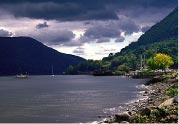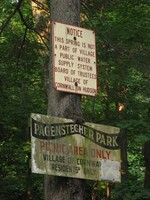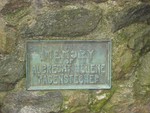 |
| January 16, 2026 |
Welcome! Click here to Login
|
 |
|
|


|
|
|
Click to visit the
Official Town Site
|
|
|
|
|
|
History: The Pagenstecher Family: From Rags to Riches

|
| The old park sign was covered in mold. |

|
| This plaque is on a stone marker in the park |

|
| Upyonda once lay beyond this stone gate |
November 29, 2006
By Warren Mumford
Cornwall-on-Hudson is a walking village. Residents are seen during all seasons of the year strolling on our streets, avenues and trails. On your way down to the river on Dock Hill Road, have you ever walked past Pagenstecher Park?
A wooden sign, partially covered with green mold, marks the location. Beneath the sign, a small brass plaque is fixed to a cairn of rock. The engraving reads "In Memory of Albrecht/Helene Pagenstecher."
Also, have you ever hiked on trails up Storm King Mountain starting from the pillars on Mountain Road? If so, you have walked on the driveway that leads to the site of a former Pagenstecher home. But who were the Pagenstechers?
A New Way of Making Paper
Albrecht was one of the most influential American businessmen of the late 19th century, rising literally from rags to riches by bringing revolutionary technology to the American paper industry in 1866. Albrecht, together with his cousins, Alberto and Rudolf, purchased the rights to the Voelter patent for making paper pulp from ground wood.
Previous to this development, paper was made from rags. Voelter developed his wood-grinding machine in cooperation with Frederick Keller in Germany. Keller's inspiration came from his observation of wasps that build their "paper" nests from partially chewed wood. The switch from rags to ground wood greatly increased the raw material available to produce pulp, reducing the cost by a factor of 7.
The Pagenstechers set up the first American ground wood pulp mill in Curtisville, Mass. (later named Interlaken, Mass.). Their first customer was Smith Paper Co. Other papermakers of the time ridiculed the idea of making paper from ground wood instead of rags, referring to the process as "shoddy." For this reason, the Pagenstechers originally delivered ground wood pulp to Smith under cover of night.
Pagenstecher Grinds Wood Pulp into Paper
The quality of paper, produced by Smith using ground wood pulp for the first time in March 1867, turned out to be more than acceptable. The technology spread very quickly with the Pagenstechers reaping massive financial benefit through royalties. Today, newsprint continues to be manufactured using ground wood pulp.
The Pagenstechers went on to build numerous pulp and paper mills throughout the northeast US and Canada, including a mill in upstate New York. This Hudson River mill near Luzerne, NY, eventually became a flagship mill of International Paper Co., which was incorporated in 1898.
Albrecht Pagenstecher and his family became quite wealthy through the development, operation and eventual sale of numerous paper mills and companies. He served on the board of directors of International Paper for many years.
Pagenstecher Met His Future Bride in Cornwall-on-Hudson
Helene Westermann and Albrecht Pagenstecher met in Cornwall-on-Hudson while on summer holiday circa 1862. Married in 1866, the couple had seven children (Albrecht Jr., Rudolf, Gustav, Helene (Smidt), Frieda, Bertha and Marie (von Estorf).
The family returned to Cornwall around the turn of the century and began to purchase property in the village including a tract on Storm King Heights off Deer Hill Road, a large parcel on the side of Storm King Mountain and also Cold Spring Farm later known as Donahue Farm.
Upyounda, A Mountain Estate
In 1905, Albrecht Jr. built a 20-room home named “Upyonda” on the Storm King property at the end of a winding driveway over a mile long. This home burned to the ground in 1955, the spectacular fire visible from miles away. The entrance to the property remains guarded by two stone pillars off Mountain Road. The land is now part of Palisades Interstate Park. Pagenstecher Park, at the head of Dock Hill Road, was donated to the Village in 1937 by Bertha Pagenstecher in memory of her parents, Albrecht Sr. and Helene.
The next time you walk down Dock Hill Road past Pagenstecher Park or hike up Storm King Mountain through the former “Upyonda” estate, remember this venerable family and ponder the part they played in revolutionizing the pulp and paper industry in 19th century America.
Comments:
|
My grandfather Richard Morrow was the gardener and chauffer for Bertha Pagenstecher in the mid 30's at the estate and it was during this time my father was born there in 1935. This aricle was wonderful to add to the stories of the Pagenstecher's that I have to pass on to my children.
Thank You
Debra (Morrow) Nolan
posted by Debra Morrow Nolan on 01/13/10 at 12:33 AM
|
|
Did the Morrow family live in the saltbox colonial adjacent to the stone pillars at the entrance to the trail on Mountain Road?
posted by John Moran on 04/28/14 at 8:10 PM
|
|
The upstate mill that became the flagship for International Paper was located in Corinth, NY. There is a park in Corinth named Pagenstecher Park that overlooks the Hudson River and a waterfall. Very pretty spot. I always wondered who the Pagenstechers were, now I know. Thanks!
posted by Nancy Bruno on 05/06/14 at 5:40 PM
|
Add a Comment:
Please signup or login to add a comment.
|
 |
|
|
|